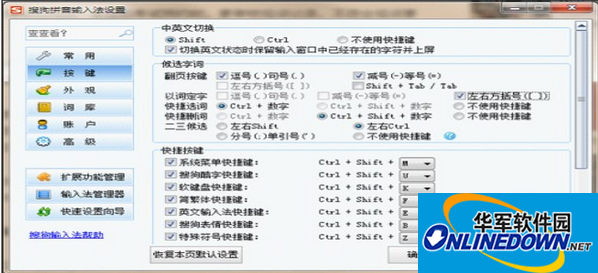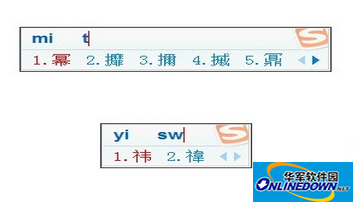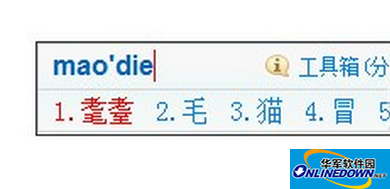
Hot search terms: 360 Security Guard Office365 360 browser WPS Office iQiyi Huawei Cloud Market Tencent Cloud Store

Hot search terms: 360 Security Guard Office365 360 browser WPS Office iQiyi Huawei Cloud Market Tencent Cloud Store

Pinyin input Storage: 133.83 MB Time: 2022-12-01
Software introduction: Baidu input method is a very cool input method launched by Baidu. It has fast typing speed, smooth use, and various skins and emojis...
Use Baidu input method to input Chinese radicals:
1. Enter the pinyin name directly. Such as "扌", we can type "扌" by inputting "ti" or clicking "tishoup" or "tishoupang" completely.
2. The wonderful use of u+. Using u+ strokes, we type out the radicals (h horizontal, s vertical, p left, n n, z fold, d dot).
For example, we want to type "氵(udd)" and "灬(uddd)". It's also very simple.
3. If you still can’t find it, use handwriting input. This is very intuitive.
Click the input method icon, right-click - Extended functions -> Handwriting input.
Baidu input method uses radicals to input unknown characters:
However, before performing the following operations, you should first set up the Sogou input method and use the "[" and "]" keys to "define the word by word". The specific settings are as shown in the figure below:

1. If you only know the radicals of some words but do not know the pronunciation of the characters, such as "stick", "Qi", etc., we can actually input them like this:
The pronunciation of u+ radical, or the sequential strokes of u+ character.

2. We know the pronunciation of some words and the glyphs, but the candidate positions are relatively late, and it would be a waste of time to keep turning the page, such as "卍", "祎", etc. We can input it like this:

Pronunciation + tab key + the first letter of the pronunciation of the radical. For example, the radical of the word "power" is "Tu Baogai", and the corresponding letter is "t". The corresponding pronunciations of the radical of the word "玥" are "s" (indicating the supplement) and "w" (Wei).
3. We only know the pronunciation of some words, but we don’t know how to write them. It doesn’t matter. We can enter them like this:
For example, "耄", we know that it is a character in "耀耋", you can enter maodie, and then press the "[" key, the first character of the current candidate will be displayed on the screen;

In addition, Sogou Pinyin input method also has a very special function: U mode radical split input, which is specially designed for inputting words that cannot be read.
After inputting the u key, enter the stroke order of a word in sequence. The stroke order is: h horizontal, s vertical, p apostrophe, n n, z fold, and you can get the word. At the same time, 1, 2, 3, 4, 5 on the small keyboard also represent h, s, p, n, z.
The stroke order rules here are exactly the same as the five-stroke input on ordinary mobile phones. The midpoint can also be entered using d.
Since Shuangpin occupies the u key, the stroke rules of Smart ABC are not five-stroke strokes, so there is no u key mode in Shuangpin and Smart ABC. It is worth mentioning that the stroke order of Shu Xin is dot dot vertical (nns) instead of vertical dot dot.
How to use the tab key to assist in inputting unknown characters using radicals:
Which: zhi+tab+d. d represents the first letter of the word "point".
Refers to: zhi+tab key+h. h represents the first letter of the word "horizontal".
Lu:lu+tab+sh. The first two strokes are because this one has more duplicate codes.
Float: fu+tab+sf. s represents "water" and f represents "fu".
Summary: The above is all the content provided by the editor. Netizens who need to know more can pay attention to our updated content.
 How does coreldraw generate barcodes - How does coreldraw generate barcodes
How does coreldraw generate barcodes - How does coreldraw generate barcodes
 How to correct pictures with coreldraw - How to correct pictures with coreldraw
How to correct pictures with coreldraw - How to correct pictures with coreldraw
 How to split cells in coreldraw - How to split cells in coreldraw
How to split cells in coreldraw - How to split cells in coreldraw
 How to center the page in coreldraw - How to center the page in coreldraw
How to center the page in coreldraw - How to center the page in coreldraw
 How to customize symbols in coreldraw - How to customize symbols in coreldraw
How to customize symbols in coreldraw - How to customize symbols in coreldraw
 Sohu video player
Sohu video player
 WPS Office
WPS Office
 Tencent Video
Tencent Video
 Lightning simulator
Lightning simulator
 MuMu emulator
MuMu emulator
 iQiyi
iQiyi
 Eggman Party
Eggman Party
 WPS Office 2023
WPS Office 2023
 Minecraft PCL2 Launcher
Minecraft PCL2 Launcher
 What to do if there is no sound after reinstalling the computer system - Driver Wizard Tutorial
What to do if there is no sound after reinstalling the computer system - Driver Wizard Tutorial
 How to switch accounts in WPS Office 2019-How to switch accounts in WPS Office 2019
How to switch accounts in WPS Office 2019-How to switch accounts in WPS Office 2019
 How to clear the cache of Google Chrome - How to clear the cache of Google Chrome
How to clear the cache of Google Chrome - How to clear the cache of Google Chrome
 How to practice typing with Kingsoft Typing Guide - How to practice typing with Kingsoft Typing Guide
How to practice typing with Kingsoft Typing Guide - How to practice typing with Kingsoft Typing Guide
 How to upgrade the bootcamp driver? How to upgrade the bootcamp driver
How to upgrade the bootcamp driver? How to upgrade the bootcamp driver